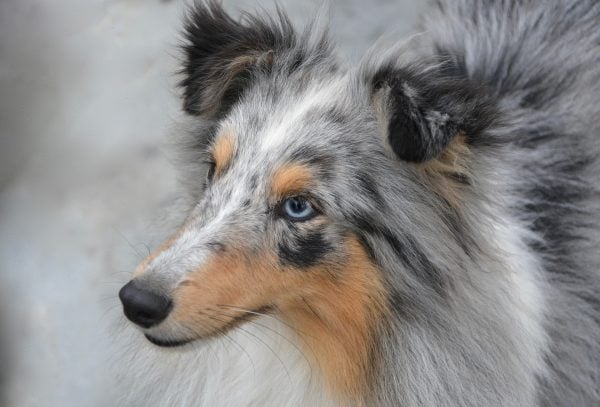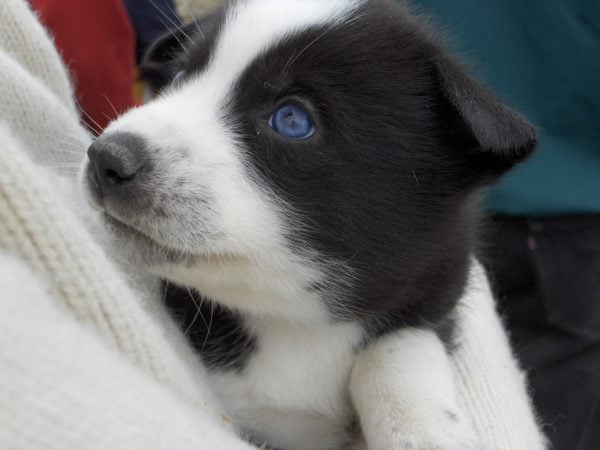Most dogs have brown eyes, so blue eyes on a dog can be a captivating sight! A dog might have blue eyes for a few different reasons, most of which have to do with the genes linked to coat pigment, or colour.
The merle gene, which dilutes coat pigment, can cause blue eyes. Albinism, a loss of pigment in the skin, coat, and eyes, can also cause blue eyes and white hair. Dogs with lots of white hair around their eyes are more likely to have blue eyes due to pigment loss. In some cases, these genes can increase your dog’s chance of blindness or deafness.
Blue eyes aren’t very common in dogs—or humans, for that matter—with the exception of Siberian Huskies. Many of them carry a rare gene that causes blue eyes.
Puppies are also born with blue eyes, but this colour will change during the first few weeks of life, according to Dr Joanne Fernandez-Lopez, director of veterinary affairs at ABCs Puppy Zs. Most puppies will have brown eyes by the time they reach the age of 12 weeks.
Read on to learn the 10 dog breeds most likely to have blue eyes, plus what this eye colour might mean for your dog.
Australian Shepherd
Australian Shepherds can have brown, amber, or blue eyes, though all three colours are pretty common. Blue eyes in Aussies are usually caused by the merle gene. This gene can also give dogs heterochromia, or eyes that are two different colours.
The merle gene can increase the chances of your dog being deaf or blind. Deafness and blindness are more likely in dogs who have a lot of white in their coat and around their eyes.
Siberian Husky
Many Siberian Huskies have blue eyes, but this eye colour has nothing to do with coat pigmentation. It doesn’t increase a Husky’s chances of blindness or deafness.
The gene that causes blue eyes in Siberian Huskies appears linked to eye development. Because it’s a dominant gene, just one copy can give these dogs at least one blue eye. Siberian Huskies can also have brown or amber eyes, or one of each: heterochromia is fairly common among Huskies, too!
Dachshund
Blue eyes in Dachshunds most commonly show up with dappled coats, which are caused by the same gene as merle coats. Most of the time, Dachshunds have brown or amber eyes, even when they have the merle gene.
Dappled Dachshunds have a higher chance of blindness or deafness, and dogs who get the dapple gene from both parents instead of just one are even more likely to be blind or deaf.
Border Collie
Border Collies typically have brown or amber eyes, but some have blue eyes. Most Border Collies who have blue eyes will also have a merle coat, but it’s possible to see blue eyes with other coat colours, too.
While Border Collies with blue eyes are more likely to have hearing or vision problems, this is more common in dogs who have a lot of white around their eyes and head.
Weimaraner
Like other puppies, Weimaraner puppies can have blue eyes. As they age, their eyes often change to grey, amber, or light brown.
That said, some adult Weimaraners may keep their blue eyes, though this eye colour is fairly rare.
Great Dane
You’ll most often see this giant breed with brown or amber eyes, but blue eyes are relatively common in Great Danes who have merle or harlequin coats.
As with most other dogs, the gene that causes these colour patterns has been linked to hearing and vision problems, especially in Great Danes who have a lot of white in their coat.
Shetland Sheepdog
Shetland Sheepdogs can have blue, brown, or amber eyes. Usually, only those with merle coats will have blue eyes—just like with Aussies.
Shetland Sheepdogs with merle coats and blue eyes have a higher risk of developing hearing or vision problems, especially if they have a lot of white in their coat.
Dalmatian
While most Dalmatians have brown eyes, you’ll also see some with blue eyes. Blue-eyed Dalmatians usually carry the piebald gene, which also causes patches of white fur.
Dalmatians with blue eyes are more likely to have congenital deafness. In fact, there’s even a myth that these dogs became a popular choice for firehouse dogs because their deafness meant the sound of sirens wouldn’t affect them! In reality, they were chosen because they could keep up with the horses that pulled the original fire engines.
Catahoula Leopard Dog
Catahoulas commonly have blue eyes, especially when they have merle or leopard-spotted coat patterns. They can also have brown or amber eyes or different-coloured eyes.
Blue eyes aren’t usually linked to health issues in Catahoula Leopard Dogs, but pups who have a lot of white around their face may have a higher risk of hearing loss. The breed, which originated in the USA, is a rare sight in the UK and Europe.
Do Dogs With Blue Eyes Have Vision Problems?
Dogs with blue eyes don’t all have vision problems, but some do.
“Blue eyes can be linked to genetic conditions, like in double-merle dogs where two merle-patterned dogs are bred together,” Dr Fernandez-Lopez says.
These dogs are more likely to have vision and hearing problems due to genetic factors. This is something to keep in mind if you’re considering breeds with the merle gene—though it’s also important to recognise that deaf and blind dogs can still live long and happy lives!
What To Do If Your Dog Has Blue Eyes
If your dog has blue eyes, it’s a good idea to schedule regular vet visits, including exams that can catch potential issues early. Blue-eyed dogs can be more sensitive to sunlight, so Dr Fernandez-Lopez also suggests keeping them in shady areas during outdoor time or using dog-friendly eye protection to help protect their eyes.
If you notice any changes in your dog’s behaviour that might suggest they’re having trouble seeing or hearing, contact your vet for a checkup and testing as soon as possible.







